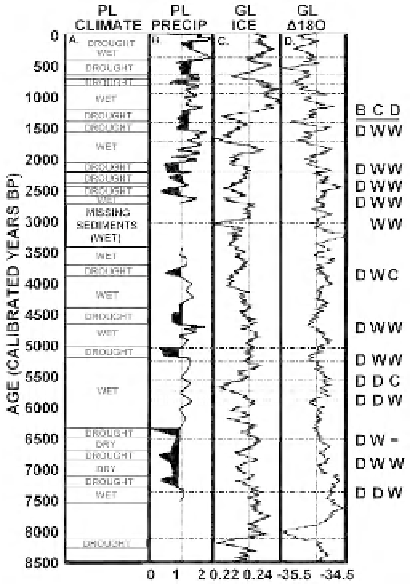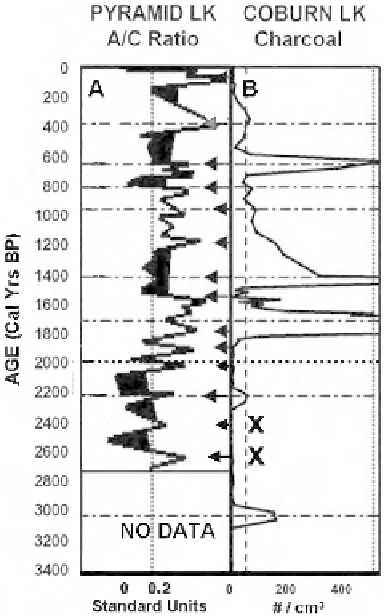Geoscience Reference
In-Depth Information
other time from 5000 to 3000 years ago (Figure 4). It is
possible that the vegetation that was growing around Coburn
Lake during this 1800 year period did not burn severely at
the onset of these severe droughts or, that if the vegetation
did burn severely, that the vegetation did not produce much
macro-sized charcoal (e.g., a vegetation type dominated by
grass or small shrubs).
Temperatures, at least, changed dramatically in the Sierra
Nevada beginning approximately 3500 years ago. Following
millennia of wide temperature
fluctuations, temperatures be-
came cooler and relatively stable in the Sierra Nevada after
approximately 3500 years ago [Potito et al., 2006].
Figure 5.
Comparison between the northern Sierra Nevada drought
record and Greenland (GL) ice accumulation and temperature records
for the past 8500 years. (a) Drought record in the northern Sierra
Nevada [Mensing et al., 2004] with the addition of the 8200 year
climate event fromCoburn Lake. (b) Northern Sierra Nevada drought
record from Pyramid Lake (PL), Nevada, based upon the ratio of
Artemisia (sagebrush) to Chenopodiaceae (shadscale) pollen types
(A/C) in Pyramid Lake sediments. Black areas denote periods of
drought. (c) Accumulation of ice (m yr
1
) through time in central
Greenland Greenland Ice Sheet Project 2 (GISP2) ice cores [Meese et
al., 1994; NSIDC and WDC-A, 1997]. (d) Greenland paleotempera-
tures derived from delta
18
O/mil [Johnsen et al., 1995; NSIDC and
WDC-A, 1997]. Vertical dashed lines denote median values for
Figures 5b
-
5d. Horizontal lines denote the times of deposition of the
largest charcoal peaks from Coburn Lake. Values to the right denote
moisture or temperature trajectories in Figures 5b
-
5d at the begin-
ning of severe droughts in the northern Sierra Nevada. In Figure 5b,
D is beginning of severe drought conditions in Sierra Nevada. In
Figure 5c, D is toward drier conditions in Greenland; W is toward
wetter conditions in Greenland. In Figure 5d, W is toward warmer
conditions in Greenland; C is toward colder conditions in Greenland.
Figure 6.
Correlation between the beginnings of severe droughts in
the northern Sierra Nevada and Coburn Lake charcoal increases over
the past 3400 years. (a) Record of droughts in northern Sierra Nevada
from Pyramid Lake, Nevada [Mensing et al., 2004] based upon the
ratio of Artemisia (sagebrush) to Chenopodiaceae (shadscale) pollen
types (A/C) derived from Pyramid Lake sediments. The dotted verti-
cal line represents the mean value for the record. (b) Number of
charcoal particles of >250
At Pyramid Lake, on the other hand, precipitation was
generally relatively high after the 5200 year ACCE. Though
two severe droughts occurred in the northern Sierra Nevada
following the 5200 year ACCE, at approximately 4600 and
3900 years ago, little or no charcoal was deposited into
Coburn Lake at the beginning of those ACCEs or at any
m in size per g
3
found within lake
sediments. The two largest Coburn Lake charcoal peaks with >1000
charcoal particles g
3
were truncated to
μ
fit the column size. Dashed
horizontal lines represent the centers of charcoal peaks. Dotted verti-
cal line denotes where samples contained >50 particles cm
3
of lake
sediment. Arrows denote locations of charcoal increases.











Search WWH ::

Custom Search